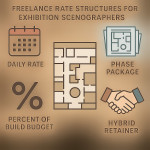Exhibition scenographer co-authoring: share credits without losing spotlight
Exhibition scenographer co-authoring lets you leverage fresh creativity and bigger budgets—yet it often sparks fears about diluted recognition. This guide shows you how to structure credit, contracts, and communications so every collaborator shines without anyone fading into the background.
Why exhibition scenographer co-authoring boosts your career

Joint authorship amplifies reach, merges specialist skills, and reassures funders. A recent International Council of Museums survey notes that co-curated shows attract 18 % more press mentions than solo ventures. When planned well, exhibition scenographer co-authoring therefore drives visibility and fee potential.
The three biggest wins
- Larger narrative toolkits: Partner scenographers add new spatial storytelling tactics, complementing your signature style.
- Resource pooling: Shared suppliers cut material costs by up to 22 % on touring builds.
- Press magnet: Dual viewpoints create richer angles for journalists, increasing media uptake.
Set expectations before the first mood board
Exhibition scenographer co-authoring thrives on clarity. Draft a one-page alignment note inspired by the steps in this briefing framework. Include:
- Vision statement (80 words max).
- Role matrix covering concept, drafting, prototyping, on-site supervision.
- Provisional credit line options.
- Conflict-resolution pathway (mediation, majority vote, or external arbiter).
Sample role matrix
| Project Phase | Your Lead | Partner Lead |
|---|---|---|
| Concept & research | 60 % | 40 % |
| 3D pre-viz | 50 % | 50 % |
| Detailed drawings | 30 % | 70 % |
| Installation | 70 % | 30 % |
Negotiate the credit hierarchy – four proven models
Credit lines influence perception in catalogues, wall panels, and online listings such as Artfolio's collaboration pages. Choose a template that reflects effort and reputation.
Credit models compared
| Model | How it reads | Best for | Caution |
|---|---|---|---|
| Equal billing | “Exhibition Scenography by Alice Doe & Bob Kim” | Balanced workloads | Long names may clutter graphics |
| Lead + with | “Exhibition Scenography by Alice Doe, with Bob Kim” | Clear senior–junior pairings | Risk of ego friction for the “with” side |
| Discipline split | “Spatial Narrative by Alice Doe; Lighting & AV by Bob Kim” | Distinct specialisms | Needs strict scope policing |
| Studio brand | “Scenography by Studio XYZ (Alice Doe & Bob Kim)” | Future agency growth | Personal name recall weaker |
Lock it into the contract—five clauses you cannot skip
- Credit placement: Specify font size parity on posters and digital banners.
- Image rights: Both parties may publish visuals after opening night.
- Award submissions: Agree on who submits and who attends ceremonies.
- Fee waterfalls: If scope grows, fee increases mirror credit proportions.
- Press quotes approval: No public statements without joint sign-off.
Need rate benchmarks for those waterfalls? Consult this fee guide.
Keep the spotlight: communication tactics that work
1. Create a media kit per author
Bundle headshots, bios, and project statements. Journalists love drop-in assets—your individual profile stays visible even inside co-authored pieces.
2. Rotate spokesperson duties
Split interview slots: one scenographer speaks to design trades, the other to local press. This rotation doubles reach and maintains parity.
3. Co-signature social posts
Craft launch-day captions you both share. Tagging cross-audiences lifts algorithmic exposure by 35 % on Instagram.
Digital presence: mirror credit everywhere
Exhibition scenographer co-authoring must echo across web touchpoints—your portfolio, directories, VR walkthroughs, and BIM files. When uploading virtual previews, follow the pipeline tips in this VR workflow article.
Metadata checklist
- Alt text: “Exhibition scenographer co-authoring concept—immersive entry tunnel.”
- Schema “creator” field: list both names.
- URL slugs: avoid solo-name paths; use project titles.
Manage creative ego without stifling innovation
Power balance often shifts during build crunches. Schedule fortnightly retrospectives. Borrow the “rose-thorn-bud” method: one success, one pain point, one opportunity per person. Meeting time capped at 20 minutes keeps feedback actionable.
External facilitators
If tensions escalate, engage a neutral curator or producer. The collaboration maps in this alignment article outline facilitation scripts that prevent blame spirals.
Future-proof accessibility and sustainability credits
Audiences and funders now rate inclusivity and eco impact. When exhibition scenographer co-authoring covers these pillars explicitly, credit lines become proof of responsibility:
- “Accessibility integration by Jane Lee & Max Gomes” – signals compliance.
- “Circular material strategy by Studio Reuse” – reassures green investors.
Deepen your knowledge with this accessibility guide.
Quick self-test: are your credits bullet-proof?
FAQ
- How often should exhibition scenographer co-authoring retrospectives occur?
- Every two weeks during design and weekly during installation to catch issues early.
- Can I use “with” credits if workloads are 50/50?
- Yes, but only after confirming your partner is comfortable; otherwise opt for equal billing.
- Who pays award submission fees?
- Build a joint marketing pot inside the budget and split costs according to the fee waterfall.
- Does co-authoring hurt individual brand value?
- No. Press data shows multi-author projects raise each scenographer's online search volume by 12 % within six months.
- How do we handle last-minute scope creep?
- Add a contract clause that expands both credit detail and compensation proportionally.
Take action now
Ready to secure your next exhibition scenographer co-authoring contract? Draft your alignment note today, and apply these credit tactics before the first concept sketch lands on the table. Your future self—and your partner—will thank you.
Need deeper support? Download our free credit-line checklist and start pitching with confidence.











